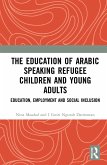Handbook for Arabic Language Teaching Professionals in the 21st Century, Volume II
Herausgeber: Wahba, Kassem M.; Taha, Zeinab A.; England, Liz
Handbook for Arabic Language Teaching Professionals in the 21st Century, Volume II
Herausgeber: Wahba, Kassem M.; Taha, Zeinab A.; England, Liz
- Gebundenes Buch
- Merkliste
- Auf die Merkliste
- Bewerten Bewerten
- Teilen
- Produkt teilen
- Produkterinnerung
- Produkterinnerung
Drawing on the collective expertise of language scholars and professional educators in a variety of sub-disciplines, this volume provides a comprehensive treatment of teaching and research in Arabic as a second and foreign language worldwide.
Andere Kunden interessierten sich auch für
![The Role of Student Motivation in Teaching Arabic as a Second Language The Role of Student Motivation in Teaching Arabic as a Second Language]() Mohamed MoghazyThe Role of Student Motivation in Teaching Arabic as a Second Language17,95 €
Mohamed MoghazyThe Role of Student Motivation in Teaching Arabic as a Second Language17,95 €![The Education of Arabic Speaking Refugee Children and Young Adults The Education of Arabic Speaking Refugee Children and Young Adults]() Nina MaadadThe Education of Arabic Speaking Refugee Children and Young Adults204,99 €
Nina MaadadThe Education of Arabic Speaking Refugee Children and Young Adults204,99 €![A Complete Arabic Grammar for English-Speaking Learners of the Arabic Language A Complete Arabic Grammar for English-Speaking Learners of the Arabic Language]() Jack KulesA Complete Arabic Grammar for English-Speaking Learners of the Arabic Language24,99 €
Jack KulesA Complete Arabic Grammar for English-Speaking Learners of the Arabic Language24,99 €![Self-Care for Allied Health Professionals Self-Care for Allied Health Professionals]() Alison BattyeSelf-Care for Allied Health Professionals204,99 €
Alison BattyeSelf-Care for Allied Health Professionals204,99 €![Young Children, Parents and Professionals Young Children, Parents and Professionals]() Margaret HenryYoung Children, Parents and Professionals410,99 €
Margaret HenryYoung Children, Parents and Professionals410,99 €![The Neo-Classic Movement in Spain During the XVIII Century, Volume 30 The Neo-Classic Movement in Spain During the XVIII Century, Volume 30]() Robert Edouard PellissierThe Neo-Classic Movement in Spain During the XVIII Century, Volume 3036,99 €
Robert Edouard PellissierThe Neo-Classic Movement in Spain During the XVIII Century, Volume 3036,99 €![The Golden Book of Arabic The Golden Book of Arabic]() Sarah Al MayoofThe Golden Book of Arabic26,99 €
Sarah Al MayoofThe Golden Book of Arabic26,99 €-
-
-
Drawing on the collective expertise of language scholars and professional educators in a variety of sub-disciplines, this volume provides a comprehensive treatment of teaching and research in Arabic as a second and foreign language worldwide.
Hinweis: Dieser Artikel kann nur an eine deutsche Lieferadresse ausgeliefert werden.
Hinweis: Dieser Artikel kann nur an eine deutsche Lieferadresse ausgeliefert werden.
Produktdetails
- Produktdetails
- Verlag: Routledge
- Seitenzahl: 458
- Erscheinungstermin: 20. Juli 2017
- Englisch
- Abmessung: 260mm x 183mm x 29mm
- Gewicht: 1050g
- ISBN-13: 9781138934764
- ISBN-10: 1138934763
- Artikelnr.: 57044798
- Herstellerkennzeichnung
- Libri GmbH
- Europaallee 1
- 36244 Bad Hersfeld
- gpsr@libri.de
- Verlag: Routledge
- Seitenzahl: 458
- Erscheinungstermin: 20. Juli 2017
- Englisch
- Abmessung: 260mm x 183mm x 29mm
- Gewicht: 1050g
- ISBN-13: 9781138934764
- ISBN-10: 1138934763
- Artikelnr.: 57044798
- Herstellerkennzeichnung
- Libri GmbH
- Europaallee 1
- 36244 Bad Hersfeld
- gpsr@libri.de
Part I. Overview: Trends and Recent Issues in Teaching and Learning Arabic
Part II. Social, Political and Educational contexts of Arabic Language
Teaching and Learninga) Arabic-speaking Worldb) Non-Arabic-speaking Worldc)
Islamic countries: Indonesia/Malaysia Part III. Identifying Core issues in
Practicea) Models of Second Language Acquisition:b) Sociolinguistic and the
Variations of Arabic in Multiple Language Communities c) History of
Teaching and Learning Arabic in Medieval Islam Part IV. Communicative
Competence and Performance in Arabic Language Teachinga) What is
Communicative Arabic?b) The Arabic language use and the educated language
user c) Integrating Vernacular with FuSHa in the Arabic as a Foreign
Language classroom d) Various Standards of Learning Arabic as a Foreign
Language in the Arabic-speaking World versus everywhere : Relevance of
ACTFL and CEFR e) Intercultural communication, curriculum development and
assessment Part V. Arabic Programs: Goals, Design and Curriculum a)
University-based Teaching and Learning: 1) University programs a. Arabic
Program-Texas University)(16)b. Lebanon: Arabic language program at the
American University in Bayrut2) Study abroad programs: a. Center of Arabic
Study Abroad (CASA) (Postgraduate level learners) (18)3) Government
Programs: ILI4) K-12 Programs5) Heritage learners and native learners Part
VI. Teaching Approachesa) Content-based Instruction b) Arabic Literature
and Literacy c) Arabic for Specific Purposes (ASP): Arabic for Businessd)
Pragmatics in Arabic Language Teachinge) Arabic language materials f)
Corpus linguistics for Arabic language teachers and learners g) Task-based
Arabic Language InstructionPart VII. Arabic language teaching and learning:
curriculum and classroom instruction a) Methodology, Classroom Management
and Lesson Planning b) Oral Skills Teaching1) Listening 2) Speaking c)
Literacy skills teaching3) Developing reading skills 4) Developing writing
skills d) Teaching and Learning Arabic pronunciation e) Teaching Grammar f)
Teaching beginner and intermediate level Vocabulary g) Motivation, Noticing
and feedback in the Arabic classroom Part VIII . Assessment, Testing and
Evaluationa) An Overview of Assessment and Evaluation: Purpose, Uses and
Types of testsb) Issue in Arabic Language Assessment in the US a) Arabic
Program Evaluation and Accreditation Part IX. Teacher Education and
Professional Developmenta) Pre- and in service Education training:
Observation, Teacher Evaluation and Certification. b) Teacher Research and
Measuring Effectiveness of Instruction Part X. Technology-mediated Teaching
and Learninga) Social media: Historical Perspective: Role and Researchb)
Distance education and Online Arabic Programs
Part II. Social, Political and Educational contexts of Arabic Language
Teaching and Learninga) Arabic-speaking Worldb) Non-Arabic-speaking Worldc)
Islamic countries: Indonesia/Malaysia Part III. Identifying Core issues in
Practicea) Models of Second Language Acquisition:b) Sociolinguistic and the
Variations of Arabic in Multiple Language Communities c) History of
Teaching and Learning Arabic in Medieval Islam Part IV. Communicative
Competence and Performance in Arabic Language Teachinga) What is
Communicative Arabic?b) The Arabic language use and the educated language
user c) Integrating Vernacular with FuSHa in the Arabic as a Foreign
Language classroom d) Various Standards of Learning Arabic as a Foreign
Language in the Arabic-speaking World versus everywhere : Relevance of
ACTFL and CEFR e) Intercultural communication, curriculum development and
assessment Part V. Arabic Programs: Goals, Design and Curriculum a)
University-based Teaching and Learning: 1) University programs a. Arabic
Program-Texas University)(16)b. Lebanon: Arabic language program at the
American University in Bayrut2) Study abroad programs: a. Center of Arabic
Study Abroad (CASA) (Postgraduate level learners) (18)3) Government
Programs: ILI4) K-12 Programs5) Heritage learners and native learners Part
VI. Teaching Approachesa) Content-based Instruction b) Arabic Literature
and Literacy c) Arabic for Specific Purposes (ASP): Arabic for Businessd)
Pragmatics in Arabic Language Teachinge) Arabic language materials f)
Corpus linguistics for Arabic language teachers and learners g) Task-based
Arabic Language InstructionPart VII. Arabic language teaching and learning:
curriculum and classroom instruction a) Methodology, Classroom Management
and Lesson Planning b) Oral Skills Teaching1) Listening 2) Speaking c)
Literacy skills teaching3) Developing reading skills 4) Developing writing
skills d) Teaching and Learning Arabic pronunciation e) Teaching Grammar f)
Teaching beginner and intermediate level Vocabulary g) Motivation, Noticing
and feedback in the Arabic classroom Part VIII . Assessment, Testing and
Evaluationa) An Overview of Assessment and Evaluation: Purpose, Uses and
Types of testsb) Issue in Arabic Language Assessment in the US a) Arabic
Program Evaluation and Accreditation Part IX. Teacher Education and
Professional Developmenta) Pre- and in service Education training:
Observation, Teacher Evaluation and Certification. b) Teacher Research and
Measuring Effectiveness of Instruction Part X. Technology-mediated Teaching
and Learninga) Social media: Historical Perspective: Role and Researchb)
Distance education and Online Arabic Programs
Part I. Overview: Trends and Recent Issues in Teaching and Learning Arabic
Part II. Social, Political and Educational contexts of Arabic Language
Teaching and Learninga) Arabic-speaking Worldb) Non-Arabic-speaking Worldc)
Islamic countries: Indonesia/Malaysia Part III. Identifying Core issues in
Practicea) Models of Second Language Acquisition:b) Sociolinguistic and the
Variations of Arabic in Multiple Language Communities c) History of
Teaching and Learning Arabic in Medieval Islam Part IV. Communicative
Competence and Performance in Arabic Language Teachinga) What is
Communicative Arabic?b) The Arabic language use and the educated language
user c) Integrating Vernacular with FuSHa in the Arabic as a Foreign
Language classroom d) Various Standards of Learning Arabic as a Foreign
Language in the Arabic-speaking World versus everywhere : Relevance of
ACTFL and CEFR e) Intercultural communication, curriculum development and
assessment Part V. Arabic Programs: Goals, Design and Curriculum a)
University-based Teaching and Learning: 1) University programs a. Arabic
Program-Texas University)(16)b. Lebanon: Arabic language program at the
American University in Bayrut2) Study abroad programs: a. Center of Arabic
Study Abroad (CASA) (Postgraduate level learners) (18)3) Government
Programs: ILI4) K-12 Programs5) Heritage learners and native learners Part
VI. Teaching Approachesa) Content-based Instruction b) Arabic Literature
and Literacy c) Arabic for Specific Purposes (ASP): Arabic for Businessd)
Pragmatics in Arabic Language Teachinge) Arabic language materials f)
Corpus linguistics for Arabic language teachers and learners g) Task-based
Arabic Language InstructionPart VII. Arabic language teaching and learning:
curriculum and classroom instruction a) Methodology, Classroom Management
and Lesson Planning b) Oral Skills Teaching1) Listening 2) Speaking c)
Literacy skills teaching3) Developing reading skills 4) Developing writing
skills d) Teaching and Learning Arabic pronunciation e) Teaching Grammar f)
Teaching beginner and intermediate level Vocabulary g) Motivation, Noticing
and feedback in the Arabic classroom Part VIII . Assessment, Testing and
Evaluationa) An Overview of Assessment and Evaluation: Purpose, Uses and
Types of testsb) Issue in Arabic Language Assessment in the US a) Arabic
Program Evaluation and Accreditation Part IX. Teacher Education and
Professional Developmenta) Pre- and in service Education training:
Observation, Teacher Evaluation and Certification. b) Teacher Research and
Measuring Effectiveness of Instruction Part X. Technology-mediated Teaching
and Learninga) Social media: Historical Perspective: Role and Researchb)
Distance education and Online Arabic Programs
Part II. Social, Political and Educational contexts of Arabic Language
Teaching and Learninga) Arabic-speaking Worldb) Non-Arabic-speaking Worldc)
Islamic countries: Indonesia/Malaysia Part III. Identifying Core issues in
Practicea) Models of Second Language Acquisition:b) Sociolinguistic and the
Variations of Arabic in Multiple Language Communities c) History of
Teaching and Learning Arabic in Medieval Islam Part IV. Communicative
Competence and Performance in Arabic Language Teachinga) What is
Communicative Arabic?b) The Arabic language use and the educated language
user c) Integrating Vernacular with FuSHa in the Arabic as a Foreign
Language classroom d) Various Standards of Learning Arabic as a Foreign
Language in the Arabic-speaking World versus everywhere : Relevance of
ACTFL and CEFR e) Intercultural communication, curriculum development and
assessment Part V. Arabic Programs: Goals, Design and Curriculum a)
University-based Teaching and Learning: 1) University programs a. Arabic
Program-Texas University)(16)b. Lebanon: Arabic language program at the
American University in Bayrut2) Study abroad programs: a. Center of Arabic
Study Abroad (CASA) (Postgraduate level learners) (18)3) Government
Programs: ILI4) K-12 Programs5) Heritage learners and native learners Part
VI. Teaching Approachesa) Content-based Instruction b) Arabic Literature
and Literacy c) Arabic for Specific Purposes (ASP): Arabic for Businessd)
Pragmatics in Arabic Language Teachinge) Arabic language materials f)
Corpus linguistics for Arabic language teachers and learners g) Task-based
Arabic Language InstructionPart VII. Arabic language teaching and learning:
curriculum and classroom instruction a) Methodology, Classroom Management
and Lesson Planning b) Oral Skills Teaching1) Listening 2) Speaking c)
Literacy skills teaching3) Developing reading skills 4) Developing writing
skills d) Teaching and Learning Arabic pronunciation e) Teaching Grammar f)
Teaching beginner and intermediate level Vocabulary g) Motivation, Noticing
and feedback in the Arabic classroom Part VIII . Assessment, Testing and
Evaluationa) An Overview of Assessment and Evaluation: Purpose, Uses and
Types of testsb) Issue in Arabic Language Assessment in the US a) Arabic
Program Evaluation and Accreditation Part IX. Teacher Education and
Professional Developmenta) Pre- and in service Education training:
Observation, Teacher Evaluation and Certification. b) Teacher Research and
Measuring Effectiveness of Instruction Part X. Technology-mediated Teaching
and Learninga) Social media: Historical Perspective: Role and Researchb)
Distance education and Online Arabic Programs








